Oak Conservatory Kits: Your Ultimate Guide to Elegant Home Extensions
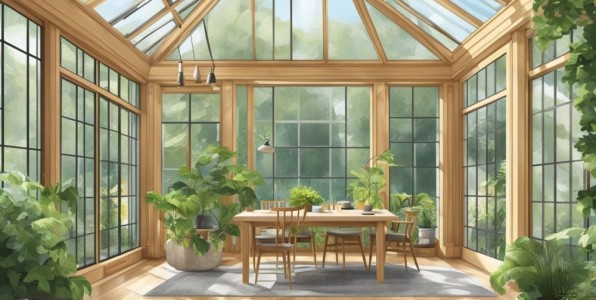
Oak Conservatory Kits: Your Ultimate Guide to Elegant Home Extensions
The post Oak Conservatory Kits: Your Ultimate Guide to Elegant Home Extensions appeared first on UK Construction Blog.
Oak conservatory kits offer homeowners a distinctive and elegant solution to extend their living space with a structure that is not only timeless in appeal but also enduring in durability. The allure of oak frames as a building material lies in its robustness and the natural warmth it adds to any design. Taking the path of a DIY kit means individuals can embark on a personal project, creating a bespoke space tailored to their specific preferences without the necessity of advanced carpentry skills.
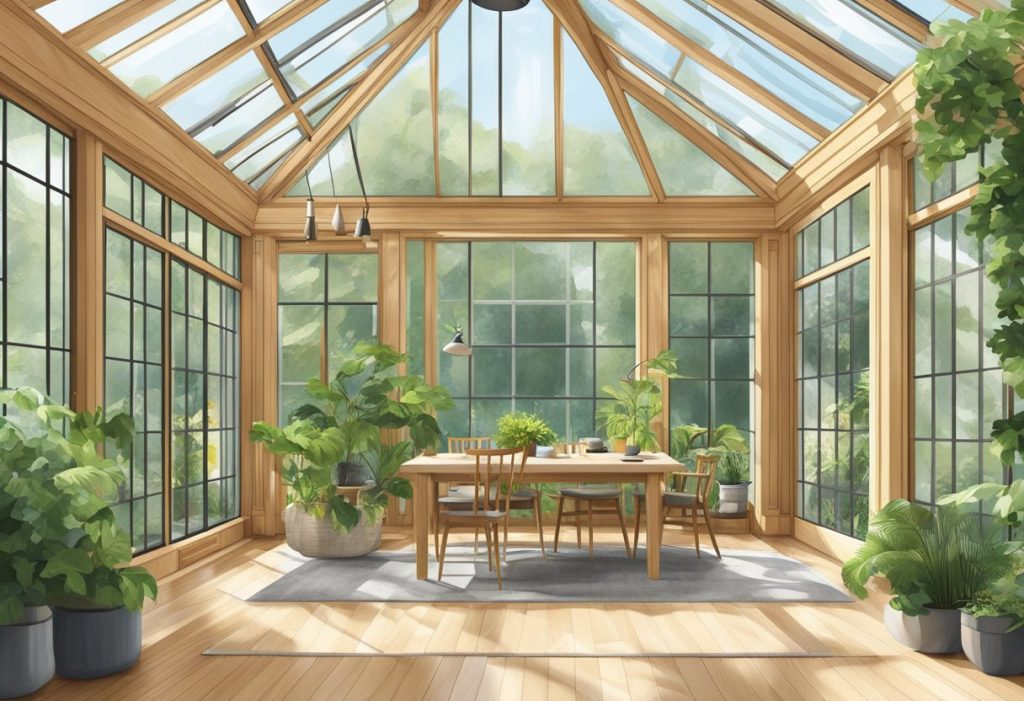
Opting for a self-build conservatory kit presents a cost-effective alternative to traditional extensions, providing an alluring addition to a property that increases its value while enhancing the quality of living space. The kits come complete with all the necessary components and detailed instructions, simplifying the assembly process. Given the range of designs and sizes available, these kits can accommodate various aesthetic and functional requirements, from expansive garden rooms to cosy nooks that invite natural light into the home.
Key Takeaways
- Oak conservatories merge aesthetics with practicality, serving as valuable home additions.
- DIY conservatory kits facilitate self-assembly while ensuring quality and precision.
- Regular care and awareness of regulations ensure longevity and legal compliance.
Understanding Oak Conservatory Kits
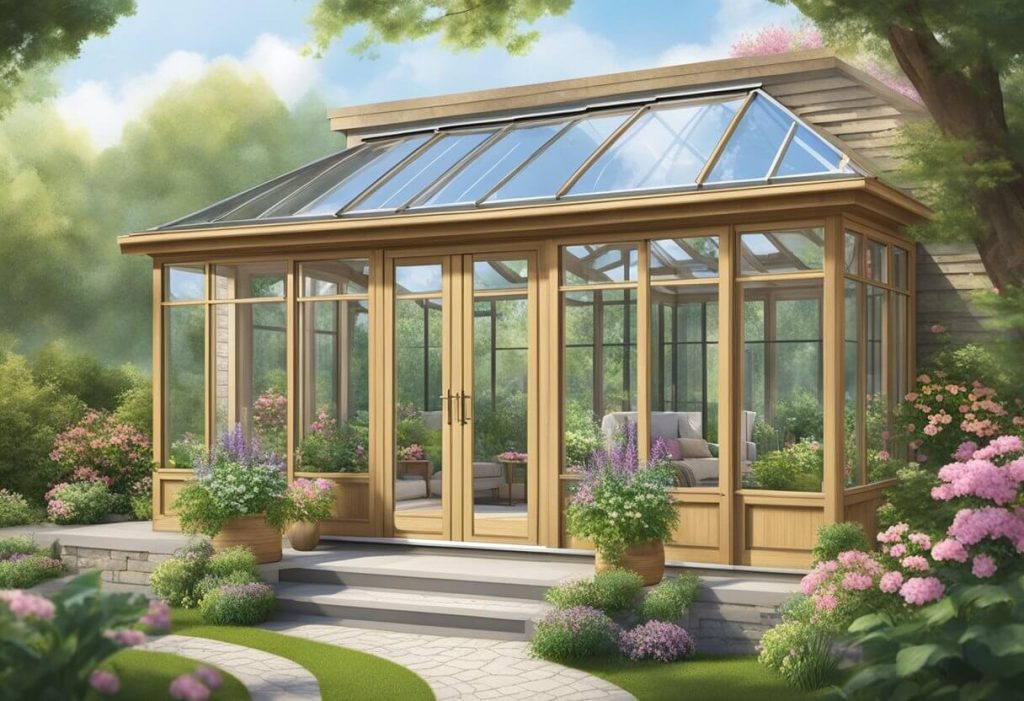
Oak conservatory kits offer a beautiful and sustainable solution for expanding home living spaces. These kits typically comprise pre-fabricated sections made from oak, a durable and aesthetically pleasing hardwood known for its longevity and resistance to shrinkage.
Components of Kits:
- Framework: Crafted from either green oak or seasoned oak, providing a robust structure.
- Windows & Doors: Options for maximising natural light and maintaining the desired thermal performance.
- Roof: Choices range from glass to achieve a contemporary look to tiled for a traditional orangery feel.
Sustainability & Maintainability: Oak is considered an environmentally responsible choice due to its sustainability. Additionally, oak conservatories require minimal maintenance but will age gracefully over time, contributing to the character of the property.
Design Options:
- Bespoke: Tailored designs to fit specific dimensions and architectural styles.
- Kits: Pre-designed options that ease the construction process.
Pricing & VAT: The cost of oak conservatory kits can vary, and it’s important to note that value-added tax (VAT) may significantly affect the final price. Prospective buyers should seek precise quotes to encompass all related expenses.
Uses:
- Oak garden rooms: Create a seamless transition between home and garden.
- Orangeries: Combine the solid build of an extension with the glass elements of a conservatory.
Selecting an oak conservatory kit allows homeowners to enhance their living space with a mix of traditional craftsmanship and contemporary design, all while keeping an eye on sustainability and quality.
Design And Planning
When considering an oak conservatory, meticulous design and comprehensive planning are indispensable to ensure the end result is both aesthetically pleasing and structurally sound. This section examines critical steps and choices to navigate from conception to completion.
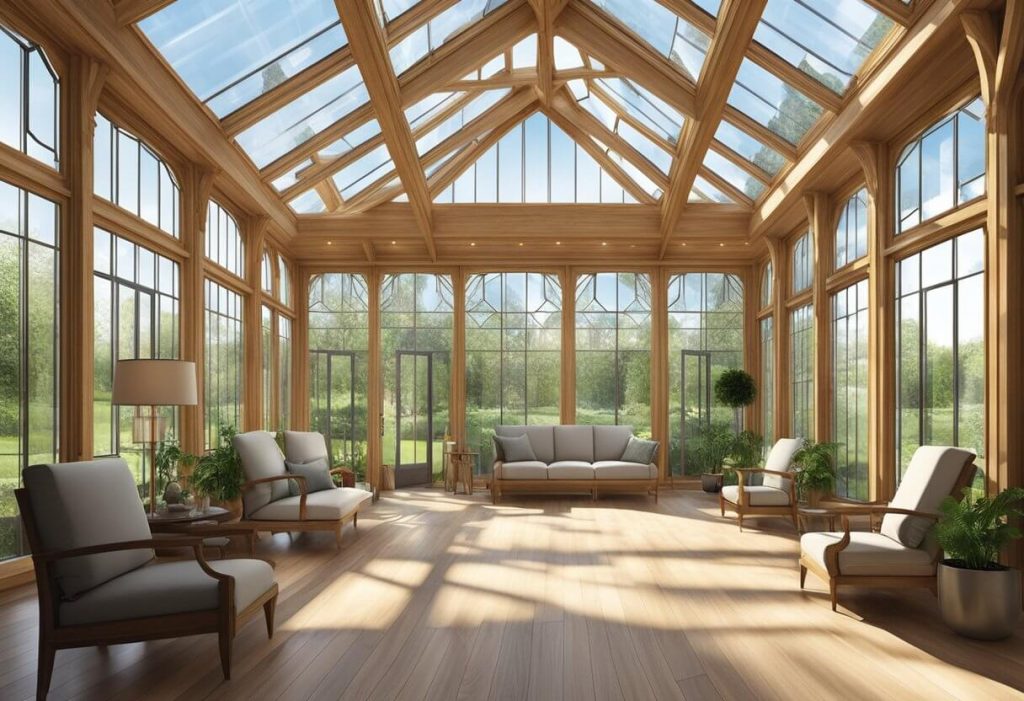
Types of Oak Conservatories
Oak conservatories come in various styles such as traditional, Victorian, and contemporary designs, as well as bespoke orangeries that merge classic architecture with modern living spaces. The choice of style affects not only the visual appeal but also the planning requirements and integration with existing structures.
Acquiring Planning Permission
Navigating planning controls is pivotal for setting up an oak conservatory. Planning permission may be mandatory, especially for listed buildings or in conservation areas. For many conservatories, however, permitted development rights may suffice, subject to size and placement regulations. Always consult the local planning authority.
Customising Your Conservatory
Bespoke design options allow for customisation of every aspect of the oak conservatory, from the selection of unique roof shapes to the choice of glazing and joinery techniques, which include mortise and tenon jointing. A gallery of past projects can provide inspiration and a better understanding of customisation offerings.
Structural Considerations
The integrity of an oak frame conservatory’s structure is reliant on expert joinery and the quality of the oak. Consider sustainable oak sources to ensure durability and environmental preservation. Every conservatory must also adhere to building regulations, which dictate the standards for construction.
Selecting the Correct Size
The appropriate size of the conservatory is determined by the intended use, whether it be a garden room for leisure or an oak frame kitchen extension for extra space. It should harmonise with the property’s scale without overwhelming it. Accurate sizing is also imperative to meet planning restrictions if applicable.
Design Styles and Options
Traditional and contemporary oak conservatory designs offer a range of aesthetic choices. Traditional styles often feature intricate detailing and classic proportions, while contemporary designs favour clean lines and minimalist aesthetics. Victorian-style conservatories, with their distinctive pitched roofs, remain a popular option for period homes.
Conservatory Roof Options
Roofs shape a conservatory’s character and functionality. Options range from vaulted ceilings to flat designs with roof vents for ventilation. Glazing choices affect the conservatory’s thermal performance and natural light entry. Potential buyers should consider options carefully to balance aesthetics with practicality.
Integrating a Conservatory with Existing Structures
Seamless integration of a new conservatory with the existing property is vital. This often involves matching architectural features and ensuring that the transition between structures is fluid and visually coherent. For new builds or extensions, the conservatory can also establish a complementary contrast to the main structure.
Environmental Considerations and Sustainability
Sustainability is a growing concern in construction. Oak conservatories should, where possible, use sustainably sourced materials. The natural insulation properties of oak and strategic use of glazing can enhance a conservatory’s energy efficiency, reducing the carbon footprint and potentially lowering heating costs.
Installation And Construction
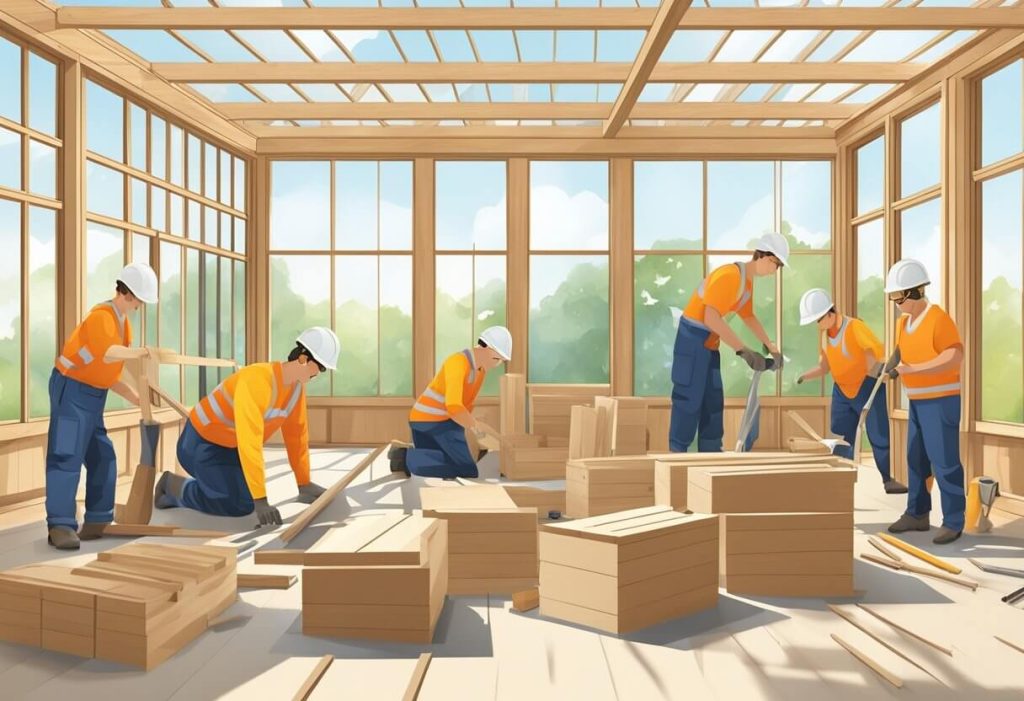
When considering an oak conservatory, installation and construction are critical components that ensure longevity and compliance. It’s essential to select a supplier and understand the kit form, weigh DIY versus professional installation, prepare for lead times, and ensure building regulations are met.
Selecting a Supplier
Choosing a reliable supplier for an oak conservatory is the foundation of a successful project. Customers should look for suppliers who offer sustainably sourced oak and demonstrate expert joinery techniques. It’s advisable to opt for companies that have a track record of delivering bespoke solutions and positive customer service. Ensure the supplier provides detailed sales information and transparent lead times.
Understanding the Kit Form
An oak conservatory kit typically includes pre-cut oak trusses and all the necessary components designed to fit together using established joinery techniques. Familiarisation with the kit form and its contents is paramount. Kits come with instructions, and understanding these instructions thoroughly before commencing construction is necessary to mitigate any issues during installation.
DIY Installation vs. Professional Assistance
A DIY installation of an oak conservatory can be an alluring option for those with the skillset and to save on costs. However, the complexity of the task should not be underestimated. Professional assistance is usually recommended, as specialists possess the required expertise to deal with listed buildings, building regulations, and to ensure a high-quality finish. Consider your budget and ability carefully before deciding which route to take.
Lead Times and Preparation
Lead times must be factored into the project planning, as bespoke oak conservatories are custom-made and can take time to manufacture. Preparation of the site should align with the lead time, ensuring it is ready for installation upon arrival of the kit. Subsequent delays can increase costs and prolong construction.
Building Regulations Compliance
It’s imperative for conservatory construction to comply with UK building regulations. This includes obtaining planning permission if necessary, especially for listed buildings or in conservation areas. Building regulations cover aspects such as structural integrity, thermal performance, and safety. When in doubt, professional advice should be sought to navigate these complexities.
Materials And Craftsmanship

When considering the construction of an oak conservatory, the choice of materials and the quality of craftsmanship play pivotal roles in determining both the aesthetic and structural integrity of the build.
Oak Species and Sourcing
The oak utilised in conservatories is often either fresh sawn oak or green oak, known for its durability and attractive appearance. These oaks are typically sustainably sourced from reputable suppliers, ensuring environmental responsibility while providing the characteristic timber needed for the structures.
Craftsmanship and Joinery Techniques
Expert joinery is vital to the construction of an oak conservatory. Craftsmanship includes traditional mortise and tenon jointing, a technique celebrated for its strength and precision in oak framework. Joinery must be executed with skill to ensure joints fit snugly without compromising the wood’s character.
Glazing Solutions and Technology
Conservatory glazing has evolved with advancements in glass technology. Modern conservatories often feature double-glazed units that are encapsulated within durable aluminium spacers. This ensures energy efficiency and longevity, while the glass itself provides clarity and protection from the elements.
Finishes and Detailing
Finishing touches include surfaces that are planed and lightly sanded to a smooth texture. Edges may be chamfered to enhance character, and a range of varnishes or stains can be applied to meet specific aesthetic desires. Every detail contributes to crafting an oak conservatory that is not only structurally sound but also visually stunning.
Maintenance And Care
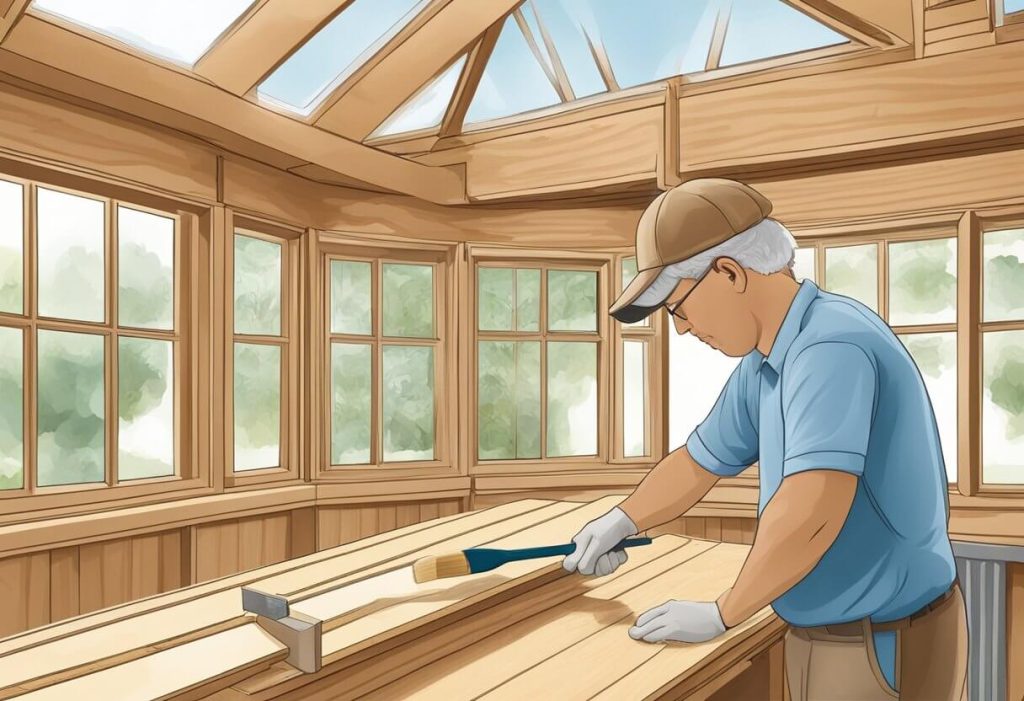
When it comes to maintaining an oak conservatory, homeowners will find that oak as a timber requires minimal effort to keep it looking its best. Oak beams are notably low maintenance; they naturally transition from a light honey colour to a silvery hue over time due to the presence of tannins reacting with the air. This process can be left to occur naturally or controlled depending on the owner’s preference.
Regular Inspection:
They should conduct regular inspections for possible issues such as:
- Timber integrity, checking for signs of wear or damage.
- Finish and sealant integrity to ensure ongoing protection.
Cleaning Methods:
For cleaning, a soft cloth and a mild detergent are usually sufficient:
- Gentle wiping to remove dirt or debris.
- Avoid harsh chemicals which can damage the wood’s integrity.
Sustainability Aspect: Those who are environmentally conscious will appreciate that oak is often sustainably sourced, ensuring minimal environmental impact. The durability of hardwoods like oak also contributes to sustainability, as their longevity means the conservatory will not require frequent replacement.
Treatment Options:
If desired, homeowners can opt for various treatments to maintain the colour and protect the timber:
- Oiling to nourish the wood and retain its natural colour.
- Sealants to protect against weathering and moisture.
It is advisable for homeowners to consult with professionals for best practices on maintaining their oak conservatories to ensure that these elegant structures continue to provide beauty and utility for years to come.
Pricing And Budgeting
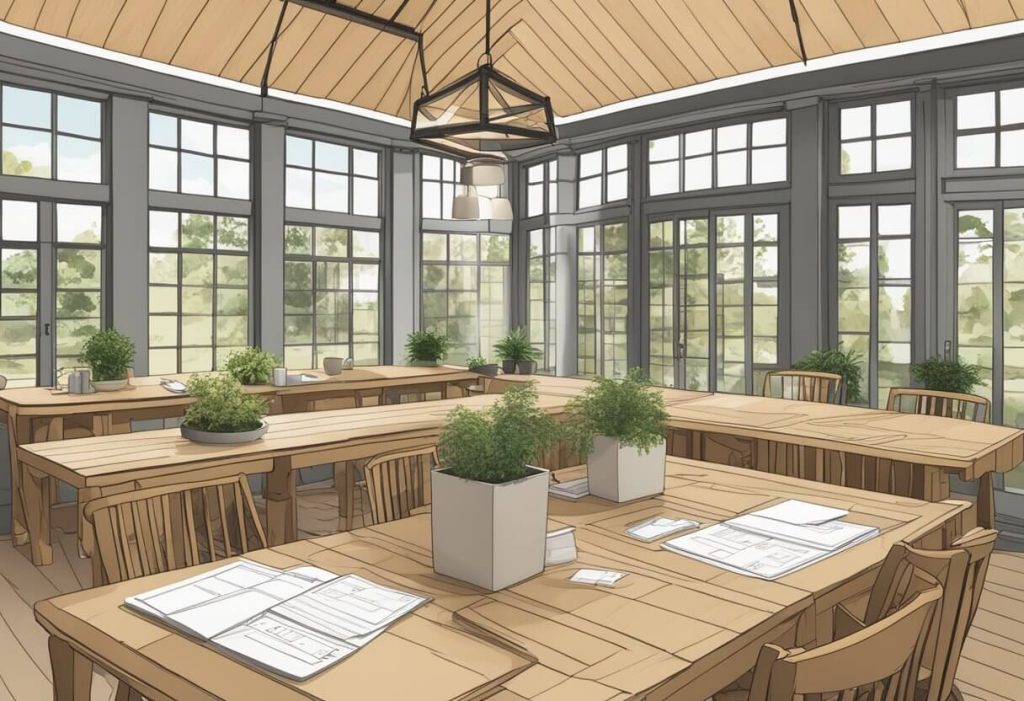
When planning for an oak conservatory, understanding the various costs and effectively budgeting are crucial. These considerations help ensure that they align with financial expectations and provide a framework for managing the project’s expenses.
Understanding the Costs
Pricing for an oak conservatory can vary widely based on factors such as size, design complexity, and materials used. Typically, one might encounter prices ranging from £450 to £850 per square metre. However, for higher-end specifications, a more realistic figure could be around £2,500 per m2 (+VAT). It’s important for the buyer to request a detailed quotation that breaks down all associated costs.
Budgeting for a Conservatory
To budget effectively for a conservatory, one should consider both the initial purchase price and additional costs such as:
- Delivery fees
- Foundations and ground work
- Construction and labour (for professional installation)
- DIY installation tools (if applicable)
- Interior finishes and furnishings
A comprehensive budget plan will also account for any potential overruns and ensure they have a buffer for unforeseen expenses.
Costs Associated with Conservatory Installation
The installation costs of an oak conservatory can differ based on whether the buyer opts for a DIY kit or a professional installation. DIY kits are generally more cost-effective and often come with easy-to-follow instructions. In contrast, professional installation will add to the overall cost but can provide the peace of mind of expert craftsmanship. VAT is another consideration, as it adds a significant percentage to the overall expenses, which should not be overlooked in the budgeting phase.
Case Studies And Gallery
This section showcases select oak conservatory projects and the valuable feedback provided by clientele. It highlights finished installations and provides a glimpse into the rich design possibilities.
Previous Installations and Testimonials
Gallery: A selection of images presents a diverse range of completed oak conservatories, detailing the expertise and craftsmanship inherent in each structure.
- Accoya Project: The use of Accoya wood demonstrates a commitment to durability and stability, meeting customer desires for traditional oak aesthetics without the associated maintenance concerns.
- Surrey Orangery: The seasoned oak orangery in Surrey echoes the client’s vision for a space that’s ideal for socialising during the warmer months, reflecting a blend of contemporary design and practical function.
Customers often express high satisfaction with the end results, noting the transformative impact on their homes and the quality of service received.
Design Inspirations
Designs: The gallery provides a rich repository of designs from simple DIY kits to bespoke, made-to-measure oak conservatories. Prospective customers can peruse a variety of styles to inspire their own projects.
- Bespoke Designs: With over two decades of experience, experts offer an array of customisable options, ensuring that each conservatory reflects the individual tastes and requirements of the customer.
- DIY Kits: For those looking for an efficient and cost-effective solution, quality DIY conservatory kits are available, enabling homeowners to personally contribute to the transformation of their living space.
Through the examination of past installations and the extensive range of design inspirations, customers are equipped with the knowledge to envision and execute their own oak conservatory project.
Benefits Of Adding An Oak Conservatory
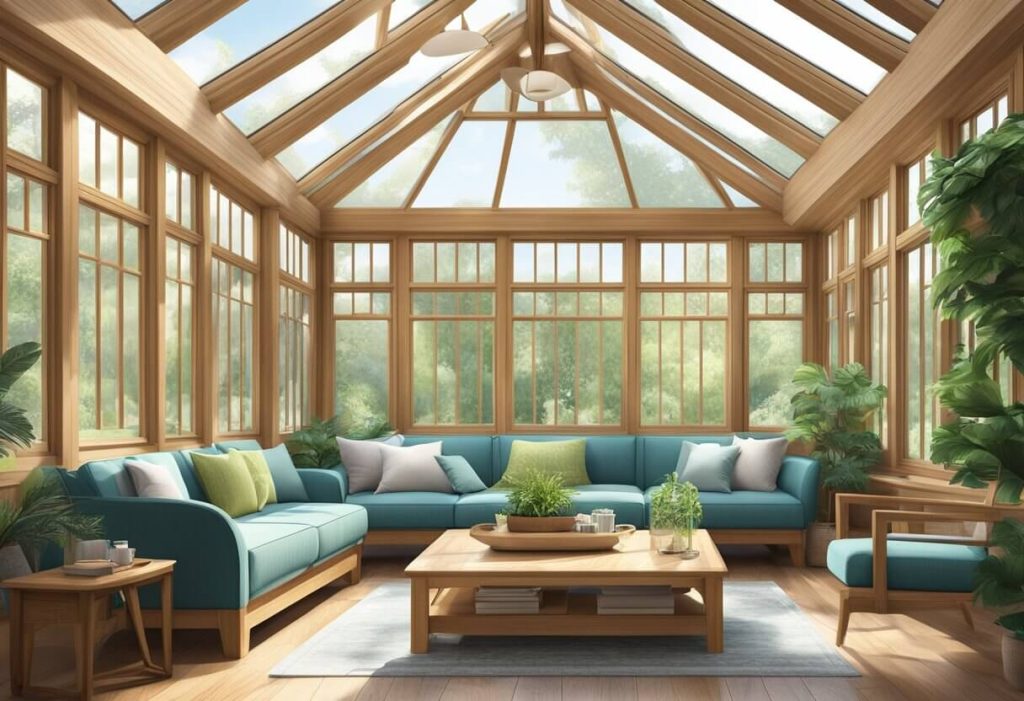
An oak conservatory is a significant addition to any property, offering a blend of aesthetic appeal and functional space. They provide extra room in a home, allowing one to enjoy the beauty of nature and the outdoors from the comfort of an indoor space. Here are some of the benefits:
- Durability and Longevity: An oak conservatory is well-regarded for its durability. Oak is a robust material that weathers well and can last for hundreds of years, making it an excellent investment for new builds or extensions.
- Attractive Design: Adding an oak conservatory is an aesthetically pleasing option. Its natural grain and warmth bring an attractive character to properties, complementing both traditional and modern homes.
- Sustainable Material: Choosing oak also benefits the environment, particularly when sourced from responsibly managed forests. For those conscious about the nature of their garden rooms, oak is sustainable.
- Added Value: Besides being a garden room that connects homeowners to their garden, it potentially increases the property’s market value. They’re seen as a desirable feature by prospective buyers.
- Versatility: Oak conservatories are versatile extensions that can serve various purposes such as a dining area, lounge, or plant space, seamlessly linking the indoors with the garden.
When considering an addition to a property, oak conservatories are not just garden rooms but are a multipurpose extension that enhances the property’s character and utility.
Heating and Ventilation Solutions

When considering an oak conservatory, key factors to address for comfort and efficiency are the thermal insulation and adequate ventilation. Solutions for these aspects are crucial for year-round usability.
Thermal Efficiency and Insulation
Thermal efficiency in oak conservatories primarily hinges on the choice of glazing and the heating system. High-quality glazed units are essential to retain heat during colder months. Double or triple glazed windows with low-emissivity (Low-E) coatings substantially reduce heat loss. For the heating system, underfloor heating (UFH) is commonly preferred for its even distribution of warmth and invisibility, keeping walls free for aesthetics and furniture.
Typical heating demands for a conservatory with a plastic roof are approximately 2,800kWh annually. Modern heating systems offer various running costs:
- Gas boiler: Approximately £170/year
- Heat pump: Around £150/year
- Wood logs: Approximately £140/year
- Electric UFH: Around £500/year
Roof Ventilation Options
Roof vents are pivotal in controlling the climate within an oak conservatory. Properly designed roof vents ensure effective air circulation and help prevent issues like dampness and overheating. These vents should conform to British Standard 5156, which mandates testing against wind and impact factors.
Options for roof vents include:
- Manual operation: Simple to install and use, but requires physical effort to open and close.
- Automatic operation: Sensors can detect temperature, rain, and wind for optimal climate control without manual intervention.
Provision of adequate roof ventilation alongside efficient glazing and heating systems creates a balanced environment, mitigating the need for excessive heating or cooling throughout the year.
Aftercare Services And Support

When opting for an oak conservatory kit, purchasers can rely on comprehensive aftercare services to maintain the longevity and beauty of their structure. Providers typically offer tailored aftercare plans, ensuring that any issues post-installation can be addressed with minimal hassle.
Maintenance: Regular maintenance is paramount for conservatories, to preserve their condition and functionality. Clients should seek professionals who specialise in oak conservatories for thorough maintenance checks.
Reliability: Aftercare services are structured to be responsive, recognising the importance of swift action should any problems arise. A reliable aftercare service is a mark of quality, providing peace of mind to the homeowner.
Professional Support: Assistance from seasoned experts is a cornerstone of aftercare services. These professionals are equipped to handle a wide range of potential issues, from structural assessments to cosmetic repairs.
Sales and Installation: The relationship between the sales process and aftercare is interconnected. Reputable suppliers ensure that clients receive not only a premium product but also a promise of ongoing support.
| Key Service | Description |
|---|---|
| Preventive Measures | Regular assessments to prevent minor issues from becoming major. |
| Responsive Solutions | Prompt addressing of any structural or aesthetic concerns. |
| Expert Guidance | Access to professional advice for the upkeep of the conservatory. |
| Sales Support | Continued support from the point of sale through to after-installation. |
Choosing a conservatory provider that offers robust aftercare services ensures a reliable, long-term investment in one’s property.
The Selection Process

When considering an oak conservatory kit, navigating through suppliers and pinpointing the right design are critical steps in the selection process.
Assessing Different Suppliers
Suppliers play a pivotal role in providing quality oak conservatory kits. One should assess them on factors like years of experience, customer service, and after-sales support. A respectable supplier usually has a substantial track record, reflecting over 20 years in the field. Customers can initiate contact via phone or an online form to discuss cost implications, which can give a sense of the supplier’s responsiveness and willingness to provide detailed information.
Example Contact Methods:
- Phone: Direct line to customer service
- Online Form: For preliminary cost estimations and enquiries
Trade references can offer insights into the supplier’s reliability and the enduring quality of their products. Someone looking for a bespoke oak conservatory should seek out a supplier like Orangeries UK, which is known for its custom frame builds.
Finding the Right Design for Your Property
Selecting the appropriate design for a property demands a careful analysis of space and personal lifestyle needs. A bespoke design enables adaptation to the size and shape of the intended site for the conservatory. An oak frame conservatory should harmonise with the existing aesthetics of one’s property and enhance its uniqueness.
To better understand the costs involved, customers can take into account current market rates. An above-average 20m² oak frame conservatory might cost around £2,500 per m² (+VAT). Prospective buyers should also think about the type of roofing that suits their preferences such as a glass roof for more natural light or a tiled roof for a traditional appearance.
Key Design Considerations:
- Size and Shape: Based on available space
- Roof Type: Glass for light, tiles for tradition
- Doors and Windows: Bi-folding for panoramic views
Investing the time to find the right design that complements one’s property will ensure the conservatory becomes a beneficial addition, potentially increasing the property’s valuation.
Oak Conservatory Regulations and Compliance
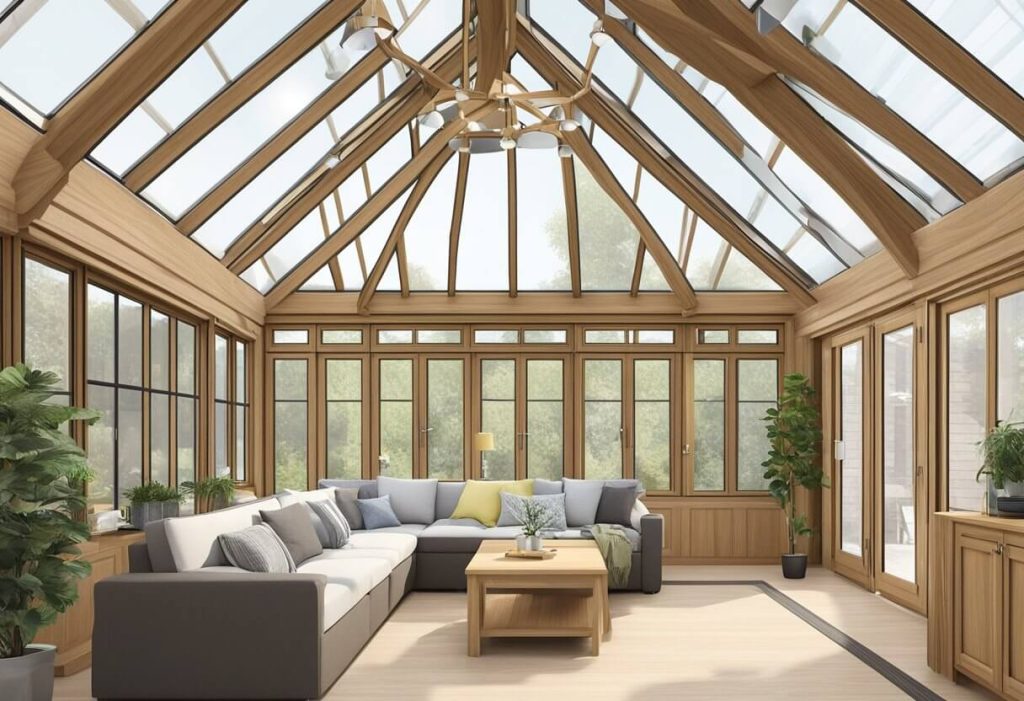
When installing an oak conservatory, homeowners must be aware of the relevant building and planning regulations to ensure legal compliance and maintain high safety and quality standards.
Navigating Building and Planning Regulations
Oak conservatories in the UK typically fall under specific building regulations and planning permissions. They must be sited at ground level and have a floor area that does not exceed 30 square metres to be considered exempt. For listed buildings or properties in conservation areas, obtaining planning permission is a critical step and should be prioritised to avoid legal complications.
- Building Regulations: To ensure compliance, oak conservatory constructions require inspection and approval from local building control bodies, adhering to the guidelines for structural integrity, thermal efficiency, and electrical safety standards.
- Planning Permission: If the conservatory deviates from certain conditions such as size and location or if the property is a listed building, planning permission from local authorities is obligatory.
Individuals should consult their local authority or a professional adviser who has a clear understanding of the Permitted Development Rights for specific guidance catered to their property.
Meeting Safety and Quality Standards
To meet rigorous safety and quality benchmarks, materials and construction processes used in oak conservatories should conform to standardised codes and practices—commonly referred to as British Standards (BS).
- Structural Safety: The design must ensure stability and resist wind and snow loads. Glazing should account for no less than 50% of the walls and have a roof more than 75% glazed, following historical guidance even though it is no longer enforceable.
- Glazing Safety: To reduce the risk of injury, it is imperative to use toughened glass in areas susceptible to human impact following BS 6206 requirements.
- Quality Control: Finishes on various surfaces can be subject to regulation under specific RAL codes, maintaining consistent quality and colour standards for materials like windows and doors.
Frequently Asked Questions
In the realm of conservatories, oak-framed kits are a popular choice for their robustness and aesthetic appeal. The following are some frequently asked questions regarding the pricing, comparison, and regulations of oak conservatory kits.
What is the typical price range for oak framed conservatory kits?
An oak framed conservatory kit could cost approximately £2,500 per m2 plus VAT, with prices fluctuating based on size, specifications, and detailing.
Are solid oak conservatories more expensive than other types?
Solid oak conservatories tend to be more expensive due to the high-quality material and craftsmanship involved when compared to conservatories made from materials like uPVC or aluminium.
What factors influence the cost of an oak framed garden room kit?
The cost is influenced by factors including the size of the conservatory, the complexity of the design, the quality of the oak, and the detail of craftsmanship.
Is planning permission required for installing an oak framed conservatory?
Planning permission may be necessary depending on the size and location of the conservatory. It is essential to consult with local planning authorities before proceeding.
How does the cost of oak frame house kits compare to traditional building methods?
Oak frame kits can be more expensive than traditional building methods due to the premium materials used and the specialised labour involved in crafting and erecting the oak frame.
What should be considered when choosing the best oak conservatory kit?
One should consider factors such as the manufacturer’s experience, materials used, design options, after-sales support, and whether the kit includes a guarantee. It’s important to contact suppliers directly for comprehensive advice tailored to individual requirements.
Comments are closed